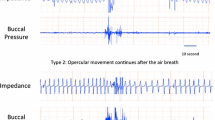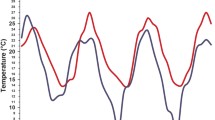Summary
While on land and recirculating branchial water the Australian semaphore crab Heloecius cordiformis (Decapoda: Ocypodidae), a semi-terrestrial airbreathing mangrove crab, sequentially depresses and elevates its carapace in a regular pump-like manner. The functional role of these carapace movements in aerial oxygen consumption is investigated. Carapace immobilisation (reversible and non-injurious) did not appear to affect branchial water circulation. In “dry” crabs (branchial water removed) carapace immobilisation had no effect on the rate of oxygen consumption (VO2), heart rate or whole-body lactate (WBL) levels. In “wet” crabs (with branchial water) carapace immobilisation caused VO2 to drop by 38% from 81 to 46 μl O2 · g-1 · h-1, heart rate to decline by 32%, from 2.5 to 1.7 Hz, and WBL levels to increase over 2.5-fold, from 0.27 to 0.67 mg · g-1, after 3 h of carapace immobilisation. The (VO2) of carapace-immobilised crabs with branchial water was similar to lung-occluded crabs with branchial water. Severe hypoxia induced physiological responses similar to those of carapace-immobilised crabs with branchial water. After 3 h of severe hypoxia, heart rate had declined by 80%, from 2.2 to 0.43 Hz, and the incidence of carapace pumping slowed by 85%, from 2.4 to 0.37 cycles · min-1. It is concluded that in the absence of carapace movements branchial water in some way inteferes with lung ventilation. Under normal circumstances water circulation and lung ventilation are mutually exclusive processes (due to their singular dependence on the scaphognathites), yet in Heloecius these processes must be carried out simultaneously. Carapace movements may alleviate this conflict.
Similar content being viewed by others
Abbreviations
- FF, FR, SF, SR:
-
fast-forward, fast-reverse, slow-forward, slow-reverse scaphognathite pumping
- MEA:
-
Milne Edwards aperture
- VO2 :
-
rate of oxygen consumption
- WBL:
-
whole-body lactate
References
Alexander SJ, Ewer DW (1969) A comparative study of some aspects of the biology and ecology of Sesarma catenata Ort. and Cyclograpsus punctatus M. Edw., with additional observations on Sesarma meinerti De Man. Zool Afr 4:1–35
Burggren W, Pinder A, McMahon B, Wheatly M, Doyle M (1985) Ventilation, circulation and their interactions in the land crab, Cardisoma guanhumi. J Exp Biol 117:133–154
Burggren W, Pinder A, McMahon B, Doyle M, Wheatly M (1990) Heart rate and haemolymph pressure responses to haemolymph volume changes in the land crab Cardisoma guanhumi: evidence for “baroreflex” regulation. Physiol Zool 63:167–181
Cameron JN (1975) Aerial gas exchange in the terrestrial Brachyura Gecarcinus lateralis and Cardisoma guanhumi. Comp Biochem Physiol 52A:129–134
Cameron JN, Mecklenburg TA (1973) Aerial gas exchange in the coconut crab, Birgus latro, with some notes on Gecarcoidea lalandii. Respir Physiol 19:245–261
Cumberlidge N, Uglow RF (1977) Heart and scaphognathite activity in the shore crab, Carcinus maenas (L.). J Exp Mar Biol Ecol 28:87–107
DeFur R, Mangum C (1979) The effects of environmental variables on the heart rates of invertebrates. Comp Biochem Physiol 62A:283–294
Dejours P (1988) Respiration in water and air. Elsevier, Amsterdam
Full RJ (1987) Locomotion energetics of the ghost crab. I. Metabolic cost and endurance. J Exp Biol 130:137–153
Full RJ, Herried CF II (1984) Fiddler crab exercise: the energetic cost of running sideways. J Exp Biol 109:141–161
Gäde G (1984) Effects of oxygen deprivation during anoxia and muscular work on the energy metabolism of the crayfish, Orconectes limosus. Comp Biochem Physiol 77A:495–502
Greenaway P, Taylor HH (1976) Aerial gas exchange in Australian arid-zone crab Parathelphusa transversa von Martens. Nature 262:711–713
Greenaway P, Taylor HH, Bonaventura J (1983) Aerial gas exchange in Australian freshwater/land crabs of the genus Holthuisana. J Exp Biol 103:237–251
Herreid CF II (1980) Hypoxia in invertebrates. Comp Biochem Physiol 67A:311–320
Herreid CF II, Lee LW, Shah GM (1979) Respiration and heart rate in exercising land crabs. Respir Physiol 36:109–120
Hoggarth KR, Trueman ER (1967) Techniques for recording the activity of aquatic invertebrates. Nature 213:1050–1051
Lallier F, Boitel F, Truchot JP (1987) The effect of ambient oxygen and temperature on haemolymph l-lactate and urate concentrations in the shore crab Carcinus maenas. Comp Biochem Physiol 86A:255–260
Macnae W (1968) A general account of the fauna and flora of mangrove swamps and forests in the Indo-West-Pacific region Adv Mar Biol 6:73–270
Maitland DP (1990a) Aerial respiration in the semaphore crab, Heloecius cordiformis, with or without branchial water. Comp Biochem Physiol 95A:267–274
Maitland DP (1990b) Carapace and branchial water circulation, and water-related behaviours in the semaphore crab Heloecius cordiformis (Decapoda: Brachyura: Ocypodidae). Mar Biol 105:275–286
Maitland DP (1990c) Feeding and mouthpart morphology in the semaphore crab Heloecius cordiformis (Decapoda: Brachyura: Ocypodidae). Mar Biol 105:287–296
Maitland DP (1992) Carapace movements associated with ventilation and irrigation of the branchial chambers in the semaphore crab, Heloecius cordiformis (Decapoda: Brachyura: Ocypodidae). J Comp Physiol B 162:365–374
McDonald DG, McMahon BR, Wood CM (1977) Patterns of heart and scaphognathite activity in the crab Cancer magister. J Exp Zool 202:33–44
McMahon BR (1988) Physiological responses to oxygen depletion in intertidal animals. Am Zool 28:39–53
McMahon BR, Burnett LE (1990) The crustacean open circulatory system: a re-examination. Physiol Zool 63:35–71
McMahon BR, Wilkens JL (1977) Periodic respiratory and circulatory performance in the rock crab Cancer productus. J Exp Zool 202:363–374
McMahon BR, Wilkens JL (1983) Ventilation, perfusion, and oxygen uptake. In: Mantel LH (ed) The biology of crustacea, vol 5. Academic Press, New York, pp 289–372
McMahon BR, Burggren WW, Wilkens JL (1974) Respiratory responses to long-term hypoxia stress in the crayfish Orconectes virilis. J Exp Biol 60:195–206
Müller F (1869) Facts and arguments for Darwin. Murray, London
O'Mahoney P (1977) Respiration and acid-base balance in brachyuran decapod crustaceans: the transition from water to land. PhD thesis, State University of New York at Buffalo, NY
Stiffler DF, Pritchard AW (1972) A comparison of in situ and in vitro responses of crustacean hearts to hypoxia. Biol Bull 143:247–255
Subrahmanyam MVV, Krishnamoorthy RV (1984) Cardiorespiratory adaptations of the freshwater field crab to different salinities. Mar Behav Physiol 11:229–238
Taylor EW (1982) Control and coordination of ventilation and circulation in crustaceans: responses to hypoxia and exercise. J Exp Biol 100:289–319
Taylor HH (1990) Pressure-flow characteristics of crab gills: implications for regulation of hemolymph pressure. Physiol Zool 63:72–89
Taylor AC, Davies PS (1981) Respiration in the land crab, Gecarcinus lateralis. J Exp Biol 93:197–208
Taylor EW, Butler PJ, Sherlock PJ (1973) The respiratory and cardiovascular changes associated with the emersion response of Carcinus maenas (L.) during environmental hypoxia, at three different temperatures. J Comp Physiol 86:95–116
Verwey J (1930) Einiges über die Biologie der ost-indischen Mangrovekrabben. Treubia 12:167–261
Wilkens JL (1981) Respiratory and circulatory coordination in decapod crustaceans. In: Herreid CF, Fortner Cr (eds) Locomotion and energetics in arthropods. Plenum Press, New York, pp 277–298
Wilkens JL, Wilkens LA, McMahon BR (1974) Central control of cardiac and scaphognathite pacemakers in the crab, Cancer magister. J Comp Physiol 90:89–104
Wood CM, Randall DJ (1981) Oxygen and carbon dioxide exchange during exercise in the land crab (Cardisoma carnifex). J Exp Zool 218:7–22
Author information
Authors and Affiliations
Rights and permissions
About this article
Cite this article
Maitland, D.P. Carapace movements aid air breathing in the semaphore crab, Heloecius cordiformis (Decapoda: Brachyura: Ocypodidae). J Comp Physiol B 162, 375–382 (1992). https://doi.org/10.1007/BF00260766
Accepted:
Issue Date:
DOI: https://doi.org/10.1007/BF00260766




